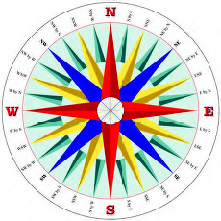
Vedic literature provides extensive detail on suitable land required for construction of residential, commercial, industrial and religious buildings. Bhavishya Puran, Agni Puran, Matsya Puran, Bramha Vaivart Puran and Narad Puran provide illustrative directions for selection of land for various buildings for proposed township, fort, religious establishment or isolated dwelling. Vedic instructions are based on class and caste composition. They prescribe separate specifications for rulers, ministers, priests, warriors, courtiers, traders and the commoners.
Agni Puran (chapter 106) portrays methodology to establish a township. It recommends entrance facing East. (There should be well laid out market places with wide roads. Entrance should be wide enough to facilitate entry of elephants. There should be 1, 2 or 3 main gates. It also recommends residence direction for people according to occupation.
Bhavishya Puran (Madhyam Parva, Pratham Bhag) contains details of land suitable for construction of buildings, orchards and religious places.
Vedic sources recommend that dwelling must be built on plots of land that are oriented towards cardinal directions i.e. North, East, South or West. This brings perimeter walls of the plot parallel to the magnetic axis of the earth. Minor variation may be accepted if other factors are favorable.
The capacity of the building to with stand hazards of tremors, cyclone, incessant rain, floods etc. depends on the quality of soil.
1. Smell
2. Colour
3. Moisture (Ras)
4. Shape of land
Plot of land sloping towards North, NE(Ishan) and East direction gives success, prosperity and affluence. Slope and depression in other directions proves harmful(Narad Puran, Poorvbhag, Dwiteeya Paad.
The plot of land where a building is proposed must first be tested, by digging a pit of the length, width and depth of one Aratni – of the person who wants to own the plot of land and construct a building (measuring from the elbow joint to the tip of the smallest finger). Then refill the pit with the dug out material. Construction on the plot brings affluence if the pit is filled, and some dug out soil is left over. Or fill the pit with water in the evening, and examine it the next morning. If some water is left over, it is an excellent piece of land. If only mud is found it is an average land. (Narad Puran PoorvBhag-Dwiteeya Paad)
Skeleton or bones of elephant and horse found on the Vaastu plot are considered auspicious, and promote well-being. Remnants/skeletons of other animals and human beings, if found buried in the plot, prove inauspicious. Water in the East, West, North and North East of a camp (colony) is considered good. Water reservoir, water fall, well, river in other directions are considered inauspicious. (Brahmavaivart Puran –Shri Krishna Janm khand)
Two more tests are prescribed in Vedic literature. Dig a pit equal in length, width and depth. Mud plaster the pit with cow dung, and light a four directional earthen lamp after sun set. Watch the last wick go off. When we test a plot of land for suitability with a four directional lamp, watch the last wicks go off. If the wick of East or North direction is the last to go off, the land is acceptable. These directions give growth, strength and happiness. A wick, if burning for a longer time, symbolizes strength of the direction. South and West should not be stronger than East and North.
For another test, stand in the middle of the plot of land, close your eyes and breathe deeply. If after five deep inhalations you feel good, and receive positive feelings, it is a good plot.
It is not necessary that a plot of land will be simultaneously suitable both for living and commercial activities
Selection Of Land
Land in question must be examined from the following angles:
♦ Orientation
♦ Quality of soil
♦ Shape and size of land
♦ Elevation level of land
♦ Slope of land
♦ Approaches and roads
♦ Surroundings – high rise buildings, depressions, hills, mounds, rivers,
nullah, slope for flow of water
♦ Religious monuments
located nearby
♦ Forest, tall trees, vegetation etc
♦ Location of grave yard/cremation ground
♦ Location of ruler/highly influential personality in close proximity
♦ Foul smell, inflammable gas,
oil pipeline and stores of
explosive material
♦ Noise, high volume sound
♦ Turbulent activities in
neighborhood.
It is essential to understand directions and their rulers/lords
East(Poorva) is ruled by Indra, the king/ruler of the Devatas.
West(Pashchim) is ruled by Varun, the lord of rains/water.
North(Uttar) is ruled by Kuber, the lord of wealth and finance.
South(Dakshin) is ruled by Yam, the lord of death.
South East(Agneya) is ruled by Agni, the lord of fire.
North East( Ishan) is ruled by Shiva, the lord of well-being and wisdom.
North West (Vayavya) is ruled by Vaayu, the lord of air.
South West (Nairut) is ruled by Nairut, the demon.
Read More...